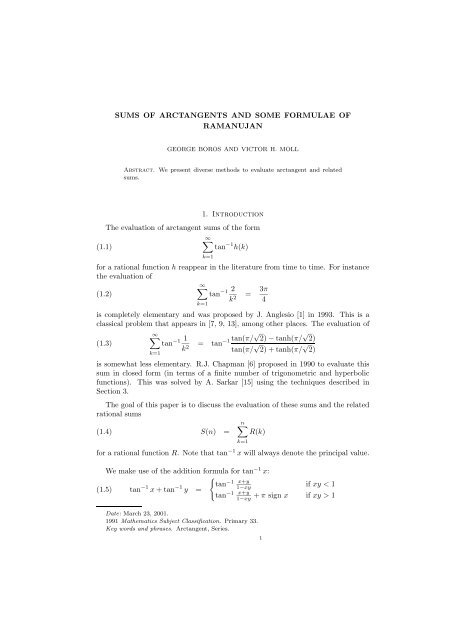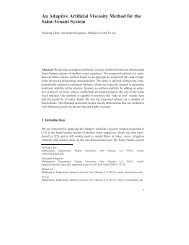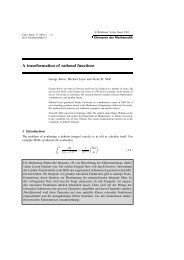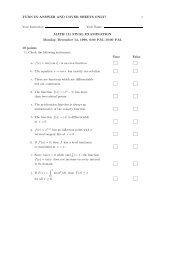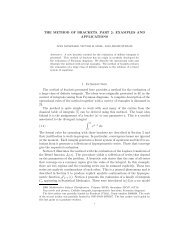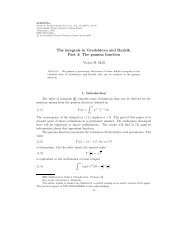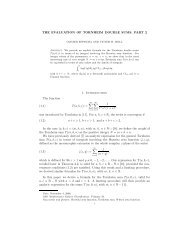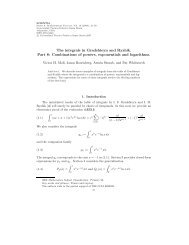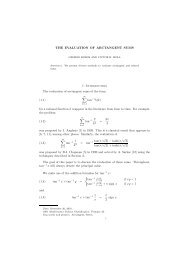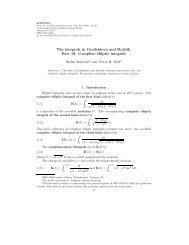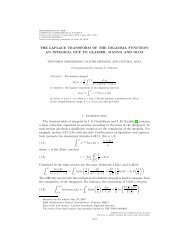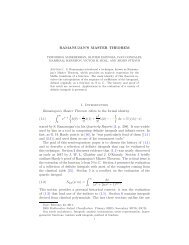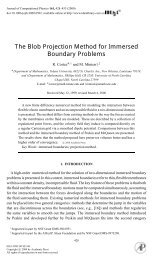Sum of Arctangents and Some Formula of Ramanujan
Sum of Arctangents and Some Formula of Ramanujan
Sum of Arctangents and Some Formula of Ramanujan
You also want an ePaper? Increase the reach of your titles
YUMPU automatically turns print PDFs into web optimized ePapers that Google loves.
SUMS OF ARCTANGENTS AND SOME FORMULAE OF<br />
RAMANUJAN<br />
GEORGE BOROS AND VICTOR H. MOLL<br />
Abstract. We present diverse methods to evaluate arctangent <strong>and</strong> related<br />
sums.<br />
1. Introduction<br />
The evaluation <strong>of</strong> arctangent sums <strong>of</strong> the form<br />
∞∑<br />
(1.1)<br />
tan −1 h(k)<br />
k=1<br />
for a rational function h reappear in the literature from time to time. For instance<br />
the evaluation <strong>of</strong><br />
∞∑<br />
(1.2)<br />
tan −1 2 k 2 = 3π 4<br />
k=1<br />
is completely elementary <strong>and</strong> was proposed by J. Anglesio [1] in 1993. This is a<br />
classical problem that appears in [7, 9, 13], among other places. The evaluation <strong>of</strong><br />
∞∑<br />
tan −1 1 k 2 = tan −1 tan(π/√ 2) − tanh(π/ √ 2)<br />
(1.3)<br />
tan(π/ √ 2) + tanh(π/ √ 2)<br />
k=1<br />
is somewhat less elementary. R.J. Chapman [6] proposed in 1990 to evaluate this<br />
sum in closed form (in terms <strong>of</strong> a finite number <strong>of</strong> trigonometric <strong>and</strong> hyperbolic<br />
functions). This was solved by A. Sarkar [15] using the techniques described in<br />
Section 3.<br />
The goal <strong>of</strong> this paper is to discuss the evaluation <strong>of</strong> these sums <strong>and</strong> the related<br />
rational sums<br />
n∑<br />
(1.4)<br />
S(n) = R(k)<br />
for a rational function R. Note that tan −1 x will always denote the principal value.<br />
We make use <strong>of</strong> the addition formula for tan −1 x:<br />
{<br />
tan<br />
tan −1 x + tan −1 −1 x+y<br />
1−xy<br />
if xy < 1<br />
(1.5)<br />
y =<br />
tan −1 + π sign x if xy > 1<br />
k=1<br />
x+y<br />
1−xy<br />
Date: March 23, 2001.<br />
1991 Mathematics Subject Classification. Primary 33.<br />
Key words <strong>and</strong> phrases. Arctangent, Series.<br />
1
2 GEORGE BOROS AND VICTOR H. MOLL<br />
<strong>and</strong><br />
(1.6) 2. The method <strong>of</strong> telescoping<br />
tan −1 x + tan −1 1 x = π 2<br />
sign x.<br />
The closed-form evaluation <strong>of</strong> a finite sum<br />
n∑<br />
S(n) :=<br />
k=1<br />
is elementary if one can find a sequence {b k } such that<br />
a k<br />
a k = b k − b k−1 .<br />
In this situation, the sum S(n) telescopes, i.e.<br />
n∑ n∑<br />
S(n) := a k = b k − b k−1 = b n − b 0 .<br />
k=1<br />
k=1<br />
This method can be extended to situations in which the telescoping nature <strong>of</strong> a k is<br />
hidden by a function.<br />
Theorem 2.1. Let f(x) be <strong>of</strong> fixed sign <strong>and</strong> define h by<br />
(2.1)<br />
Then<br />
(2.2)<br />
h(x) =<br />
f(x + 1) − f(x)<br />
1 + f(x + 1)f(x) .<br />
n∑<br />
tan −1 h(k) = tan −1 f(n + 1) − tan −1 f(1).<br />
k=1<br />
In particular, if f has a limit at ∞ (including the possibility <strong>of</strong> f(∞) = ∞), then<br />
∞∑<br />
(2.3)<br />
tan −1 h(k) = tan −1 f(∞) − tan −1 f(1).<br />
Pro<strong>of</strong>. Since<br />
k=1<br />
(2.2) follows by telescoping.<br />
tan −1 h(k) = tan −1 f(k + 1) − tan −1 f(k),<br />
Note. The hypothesis on the sign <strong>of</strong> f is included in order to avoid the case xy > 1<br />
in (1.5). In general, (2.2) has to be replaced by<br />
n∑<br />
(2.4) tan −1 h(k) = tan −1 f(n) − tan −1 f(1) + π ∑ sign f(k),<br />
k=1<br />
where the sum is taken over all k between 1 <strong>and</strong> n for which f(k)f(k + 1) < −1.<br />
Thus (2.2) is always correct up to an integral multiple <strong>of</strong> π. The restrictions on<br />
the parameters in the examples described in this paper have the intent <strong>of</strong> keeping<br />
f(k), k ∈ N <strong>of</strong> fixed sign.<br />
Example 2.1. Let f(x) = ax + b, where a, b are such that f(x) ≥ 0 for x ≥ 1.<br />
Then<br />
a<br />
(2.5)<br />
h(x) =<br />
a 2 x 2 + a(a + 2b)x + (1 + ab + b 2 )
3<br />
<strong>and</strong> (2.3) yields<br />
∞∑<br />
tan −1<br />
a<br />
(2.6)<br />
a 2 k 2 + a(a + 2b)k + (1 + ab + b 2 )<br />
k=1<br />
= π 2 − tan−1 (a + b).<br />
Special cases: a = 1 <strong>and</strong> b = 0 give f(x) = x <strong>and</strong> h(x) = 1/(x 2 + x + 1), <strong>and</strong> the<br />
sum is<br />
∞∑<br />
(2.7)<br />
tan −1 1<br />
k 2 = π + k + 1 4 .<br />
k=1<br />
• a = 2 <strong>and</strong> b = 0 give f(x) = 2x <strong>and</strong> h(x) = 2/(2x + 1) 2 , so that<br />
∞∑<br />
(2.8)<br />
tan −1 2<br />
(2k + 1) 2 = π 2 .<br />
k=0<br />
Differentiating (2.6) with respect to a yields<br />
∞∑<br />
(2.9)<br />
p a,b (k)<br />
1<br />
=<br />
q a,b (k) 1 + (a + b) 2 ,<br />
where<br />
<strong>and</strong><br />
k=1<br />
p a,b (k) = a 2 k 2 + a 2 k − (1 + b 2 )<br />
q a,b (k) = a 4 k 4 + 2a 3 (a + 2b)k 3 + a 2 (2 + a 2 + 6ab + 6b 2 )k 2 +<br />
2a(a + 2b)(1 + ab + b 2 )k + (1 + b 2 )(1 + a 2 + 2ab + b 2 ).<br />
Special cases: a = 1 <strong>and</strong> b = 0 give<br />
∞∑ k 2 + k − 1<br />
k 4 + 2k 3 + 3k 2 + 2k + 2<br />
k=1<br />
= 1 2 .<br />
• a = 1/2 <strong>and</strong> b = 1/3 give<br />
∞∑<br />
9k 2 + 9k − 40<br />
81k 4 + 378k 3 + 1269k 2 + 1932k + 2440<br />
k=1<br />
k=1<br />
= 1<br />
61 .<br />
• Let a = −2b <strong>and</strong> differentiate with respect to b to produce<br />
∞∑ 4b 2 k 2 − (1 + b 2 )<br />
1<br />
16b 4 k 4 + 8b 2 (1 − b 2 )k 2 + (1 + b 2 ) 2 =<br />
2(1 + b 2 ) .<br />
Mathematica evaluates this last sum.<br />
Example 2.2. This example considers the quadratic function f(x) = ax 2 + bx + c<br />
under the assumption that f(k), k ∈ N has fixed sign. For instance this happens if<br />
b 2 − 4ac ≤ 0. Define<br />
a 0 := 1 + ac + bc + c 2<br />
a 1 := ab + b 2 + 2ac + 2bc<br />
a 2 := a 2 + 3ab + b 2 + 2ac<br />
a 3 := 2a(a + b)<br />
a 4 := a 2
4 GEORGE BOROS AND VICTOR H. MOLL<br />
Then<br />
(2.10)<br />
<strong>and</strong> thus<br />
h(x) =<br />
2ax + a + b<br />
a 4 x 4 + a 3 x 3 + a 2 x 2 + a 1 x + a 0<br />
∞∑<br />
tan −1 2ak + a + b<br />
a 4 k 4 + a 3 k 3 + a 2 k 2 + a 1 k + a 0<br />
= π 2 − tan−1 (a + b + c).<br />
k=1<br />
Special cases: b = −a, c = a/2 yields<br />
∞∑<br />
tan −1 8ak<br />
4a 2 k 4 + (a 2 + 4)<br />
k=1<br />
= π 2 − tan−1 a 2 .<br />
The particular case a = 1, b = −1 <strong>and</strong> c = 1/2 gives<br />
∞∑<br />
(2.11)<br />
tan −1 8k<br />
4k 4 = π + 5 2 − 1 tan−1 2 .<br />
k=1<br />
• b = −a, c = 0 yields the sum<br />
∞∑<br />
(2.12)<br />
tan −1 2ak<br />
a 2 k 4 − a 2 k 2 + 1<br />
k=1<br />
which is independent <strong>of</strong> a.<br />
= π 2 ,<br />
Additional examples can be given by telescoping twice (or even more).<br />
Corollary 2.2. Let f <strong>and</strong> h be related by<br />
(2.13)<br />
h(x) =<br />
f(x + 1) − f(x − 1)<br />
1 + f(x + 1)f(x − 1) .<br />
Then<br />
n∑<br />
tan −1 h(k) = tan −1 f(n + 1) − tan −1 f(1) + tan −1 f(n) − tan −1 f(0).<br />
k=1<br />
In particular,<br />
∞∑<br />
(2.14) tan −1 h(k) = 2 tan −1 f(∞) − tan −1 f(1) − tan −1 f(0).<br />
k=1<br />
Pro<strong>of</strong>. The relation (2.13) shows that<br />
Thus<br />
=<br />
tan −1 h(k) = tan −1 f(k + 1) − tan −1 f(k − 1).<br />
n∑<br />
tan −1 h(k) =<br />
k=1<br />
n∑ [<br />
tan −1 f(k + 1) − tan −1 f(k − 1) ]<br />
k=1<br />
n∑ [<br />
tan −1 f(k + 1) − tan −1 f(k) ] +<br />
k=1<br />
n∑ [<br />
tan −1 f(k) − tan −1 f(k − 1) ]<br />
k=1<br />
= tan −1 f(n + 1) − tan −1 f(1) + tan −1 f(n) − tan −1 f(0).
5<br />
Example 2.3. The evaluation<br />
∞∑<br />
(2.15)<br />
tan −1 2 k 2 = 3π 4<br />
k=1<br />
corresponds to f(k) = k so that h(k) = 2/k 2 . This is the problem proposed by<br />
Anglesio [1].<br />
Example 2.4. Take f(k) = −2/k 2 so that h(k) = 8k/(k 4 − 2k 2 + 5). It follows<br />
that<br />
∞∑<br />
tan −1 8k<br />
k 4 − 2k 2 = π − tan −1 1 + 5<br />
2 .<br />
k=1<br />
This sum is part b) <strong>of</strong> the Problem proposed in [1].<br />
Example 2.5. Take f(k) = −a/(k 2 + 1). Then h(k) = 4ak/(k 4 + a 2 + 4), so that<br />
∞∑<br />
tan −1 4ak<br />
(2.16)<br />
k 4 + a 2 = tan −1 a + 4<br />
2 + tan−1 a.<br />
k=1<br />
Special cases: a = 1 yields<br />
∞∑<br />
(2.17)<br />
tan −1 4k<br />
k 4 + 5<br />
• a = √ 2 gives<br />
(2.18)<br />
k=1<br />
∞∑<br />
k=1<br />
tan −1 4√ 2k<br />
k 4 + 6<br />
= π 4 + tan−1 1 2 .<br />
= π 2 .<br />
• Differentiating (2.16) with respect to a gives<br />
∞∑<br />
4k(k 4 + 4 − a 2 )<br />
k 8 + 2(a 2 + 4)k 4 + 16a 2 k 2 + (a 4 + 8a 2 + 16)<br />
k=1<br />
The special case a = 0 yields<br />
(2.19)<br />
<strong>and</strong> a = 2 gives<br />
(2.20)<br />
∞∑<br />
k=1<br />
∞∑<br />
k=1<br />
k<br />
k 4 + 4<br />
= 3 8<br />
k 5<br />
k 8 + 16k 4 + 64k 2 + 64<br />
=<br />
= 9 80 .<br />
Mathematica evaluates the first sum but not the second.<br />
3(a 2 + 2)<br />
(a 2 + 1)(a 2 + 4) .<br />
The examples described above are rather artficial. The interesting question is<br />
to find f(x) given the function h. In general it is not possible to find f in closed<br />
form. In the case <strong>of</strong> Example 2.3, we need to solve the functional equation<br />
(2.21)<br />
2 [1 + f(x − 1)f(x + 1)] = x 2 [f(x + 1) − f(x − 1)] .<br />
A polynomial solution <strong>of</strong> (2.21) must have degree at most 2 <strong>and</strong> trying f(x) =<br />
ax 2 + bx + c yields f(x) = x.
6 GEORGE BOROS AND VICTOR H. MOLL<br />
3. The method <strong>of</strong> zeros<br />
A different technique for the evaluation <strong>of</strong> arctangent sums is based on the factorization<br />
<strong>of</strong> the product<br />
n∏<br />
(3.1)<br />
p n := (a k + ib k )<br />
k=1<br />
with a k , b k ∈ R. The argument <strong>of</strong> p n is given by<br />
n∑<br />
Arg(p n ) = tan −1 b k<br />
.<br />
a k<br />
k=1<br />
Example 3.1. Let<br />
(3.2)<br />
p n (z) =<br />
n∏<br />
(z − z k )<br />
k=1<br />
be a polynomial with real coefficients. Then<br />
n∑<br />
Arg(p n (z)) = tan −1 x − x k<br />
(3.3)<br />
.<br />
y − y k<br />
The special case p n (z) = z n − 1 has roots at z k = cos(2πk/n) + i sin(2πk/n), so we<br />
obtain<br />
n∑<br />
(3.4)<br />
Arg(z n −1 x − cos(2πk/n)<br />
− 1) = tan<br />
y − sin(2πk/n) .<br />
k=1<br />
k=1<br />
Example 3.2. The classical factorization<br />
∞∏<br />
(3.5)<br />
sin πz = πz<br />
k=1<br />
yields the evaluation<br />
∞∑<br />
(3.6)<br />
tan −1 2xy<br />
k 2 − x 2 + y 2 = tan −1 y x<br />
k=1<br />
(1 − z2<br />
k 2 )<br />
− tan−1<br />
tanh πy<br />
tan πx .<br />
Special cases: x = y yields<br />
∞∑<br />
(3.7)<br />
−1 2x2<br />
tan<br />
k 2 = π tanh πx<br />
− tan−1<br />
4 tan πx .<br />
k=1<br />
k=1<br />
• x = y = 1/ √ 2 gives<br />
∞∑<br />
(3.8)<br />
tan −1 1 k 2 = π 4 − tanh (π/√ 2)<br />
tan−1 tan(π/ √ 2) ,<br />
which corresponds to (1.3).<br />
• x = y = 1/2 yields<br />
(3.9)<br />
∞∑<br />
k=1<br />
tan −1 1<br />
2k 2 = π 4 .
7<br />
• Differentiating (3.7) gives<br />
∞∑ k 2<br />
(3.10)<br />
k 4 + 4x 4 = π sin 2πx − sinh 2πx<br />
4x cos 2πx − cosh 2πx .<br />
k=1<br />
In particular, x = 1 yields<br />
(3.11)<br />
∞∑<br />
k=1<br />
k 2<br />
k 4 + 4<br />
= π 4<br />
coth π.<br />
The identity (3.10) is comparable to <strong>Ramanujan</strong>’s evaluation<br />
∞∑ k 2<br />
π<br />
k 4 + x 2 k 2 + x 4 =<br />
2x √ sinh πx √ 3 − √ 3 sin πx<br />
(3.12)<br />
3 cosh πx √ 3 − cos πx<br />
k=1<br />
discussed in [3], Entry 4 <strong>of</strong> Chapter 14.<br />
Glasser <strong>and</strong> Klamkin [10] present other examples <strong>of</strong> this technique.<br />
4. A functional equation<br />
The table <strong>of</strong> sums <strong>and</strong> integrals [11] contains a small number <strong>of</strong> examples <strong>of</strong><br />
finite sums that involve trigonometric functions <strong>of</strong> multiple angles. In Section 1.36<br />
we find<br />
n∑<br />
(4.1)<br />
2 2k sin 4 x 2 k = 2 2n sin 2 x 2 n − sin2 x<br />
(4.2)<br />
k=1<br />
n∑<br />
k=1<br />
1 x<br />
2 2k sec2 2 k = cosec 2 x − 1 x 2 2n cosec2 2 n<br />
<strong>and</strong> Section 1.37 consists entirely <strong>of</strong> the two sums<br />
n∑<br />
(4.3) 1<br />
2 k tan x 2 k = 1<br />
2 n cot x − 2 cot 2x<br />
2n k=0<br />
∑ n (4.4)<br />
1 x<br />
2 2k tan2 2 k = 22n+2 − 1<br />
3 · 2 2n−1 + 4 cot2 2x − 1 x 2 2n cot2 2 n .<br />
k=0<br />
In this section we present a systemtatic procedure to analyze these sums.<br />
Theorem 4.1. Let<br />
∞∑<br />
∞∑<br />
(4.5) F (x) = f(x, k) <strong>and</strong> G(x) = (−1) k f(x, k).<br />
k=1<br />
Suppose f(x, 2k) = νf(λ(x), k) for some ν ∈ R <strong>and</strong> a function λ : R → R. Then<br />
(4.6)<br />
k=1<br />
n−1<br />
∑<br />
F (x) = (2ν) n F (λ (n) (x)) − (2ν) j G(λ (j) (x)).<br />
Pro<strong>of</strong>. Observe that<br />
∞∑<br />
∞∑<br />
F (x) + G(x) = 2 f(x, 2k) = 2ν f(λ(x), k) = 2νF (λ(x)).<br />
k=1<br />
Repeat this argument to obtain the result.<br />
k=1<br />
j=0
8 GEORGE BOROS AND VICTOR H. MOLL<br />
Example 4.1. Let f(x, k) = 1/(x 2 + k 2 ), so that ν = 1/4 <strong>and</strong> λ(x) = x/2. Since<br />
<strong>and</strong><br />
F (x) =<br />
G(x) =<br />
∞∑<br />
k=1<br />
∞∑<br />
k=1<br />
1 πx coth πx − 1<br />
x 2 =<br />
+ k2 2x 2<br />
(−1) k πx csch πx − 1<br />
x 2 =<br />
+ k2 2x 2 ,<br />
(4.6) yields, upon letting n → ∞,<br />
(4.7)<br />
∞∑<br />
j=0<br />
x<br />
sinh 2 −j x − 2j = 1 − x<br />
tanh x .<br />
Now replace x by ln t, differentiate with respect to t, <strong>and</strong> set t = e to produce<br />
(4.8)<br />
∞∑<br />
j=0<br />
2 j − coth 2 −j<br />
2 j sinh 2 −j = 1 + 4e2 − e 4<br />
1 − 2e 2 + e 4 .<br />
Now go back to (4.7), replace x by ln t, differentiate with respect to t, set t = ae,<br />
differentiate with respect to a, <strong>and</strong> set a = e to produce<br />
(4.9)<br />
∞∑<br />
j=0<br />
2 − 2 2j + csch 2 2 −j − sech 2 2 −j<br />
2 2j sinh2 1−j = e12 − 17e 8 − 17e 4 + 1<br />
e 12 − 3e 8 + 3e 4 − 1 .<br />
Corollary 4.2. Let<br />
∞∑ ( x<br />
)<br />
(4.10) F (x) = f<br />
k<br />
k=1<br />
Then, for any n ∈ N,<br />
<strong>and</strong> G(x) =<br />
∞∑<br />
(−1) k f<br />
k=1<br />
( x<br />
k<br />
)<br />
.<br />
n∑<br />
(4.11)<br />
F (x) = 2 −n F (2 n x) + 2 −k G(2 k x).<br />
In particular, if F is bounded, then<br />
k=1<br />
(4.12)<br />
F (x) =<br />
∞∑<br />
2 −k G(2 k x).<br />
k=1<br />
Pro<strong>of</strong>. The function f(x/k) satisfies the conditions <strong>of</strong> Theorem 4.1 with ν = 1 <strong>and</strong><br />
λ(x) = x/2. Thus<br />
n−1<br />
∑<br />
F (x) = 2 n F (x/2 n ) − 2 j G(x/2 j ).<br />
Now replace x by x/2 n to obtain (4.11). Finally let n → ∞ to obtain (4.12).<br />
j=1<br />
The key to the pro<strong>of</strong> <strong>of</strong> Theorem 4.1 is the identity F (x) + G(x) = 2νF (λ(x)).<br />
We now present an extension <strong>of</strong> this result.
9<br />
Theorem 4.3. Let F, G be functions that satisfy<br />
(4.13)<br />
F (x) = r 1 F (m 1 x) + r 2 G(m 2 x)<br />
for some parameters r 1 , r 2 , m 1 , m 2 . Then<br />
(4.14)<br />
r 2<br />
n ∑<br />
k=1<br />
r k−1<br />
1 G(m k−1<br />
1 m 2 x) = F (x) − r n 1 F (m n 1 x).<br />
Pro<strong>of</strong>. Replace x by m 1 x in (4.13) to produce<br />
which, when combined with (4.13), gives<br />
F (m 1 x) = r 1 F (m 2 1x) + r 2 G(m 2 m 1 x),<br />
F (x) = r 2 1F (m 2 1x) + r 1 r 2 G(m 1 m 2 x) + r 2 G(m 2 x).<br />
<strong>Formula</strong> (4.14) follows by induction.<br />
We now present two examples that illustrate Theorem 4.3. These sums appear<br />
as entries in <strong>Ramanujan</strong>’s Notebooks.<br />
Example 4.2. The identity<br />
(4.15)<br />
cot x = 1 2 cot x 2 − 1 2 tan x 2<br />
shows that F (x) = cot x, G(x) = tan x satisfy (4.13) with r 1 = 1/2, r 2 = −1/2 <strong>and</strong><br />
m 1 = m 2 = 1/2. We conclude that<br />
(4.16)<br />
n∑<br />
k=1<br />
2 −k tan x 2 k = 1<br />
2 n cot x − cot x.<br />
2n This is (4.3). It also appears as Entry 24, p. 364, <strong>of</strong> <strong>Ramanujan</strong>’s Third Notebook<br />
as described in Berndt [4], p. 396. Similarly, the identity<br />
(4.17)<br />
sin 2 (2x) = 4 sin 2 x − 4 sin 4 x<br />
yields (4.1). The reader is invited to produce pro<strong>of</strong>s <strong>of</strong> (4.2) <strong>and</strong> (4.4) in the style<br />
presented here.<br />
Example 4.3. The identity<br />
(4.18)<br />
cot x = cot x 2 − csc x<br />
satisfies (4.13) with F (x) = cot x, G(x) = csc x <strong>and</strong> parameters r 1 = 1, r 2 =<br />
−1, m 1 = 1/2, m 2 = 1. We obtain<br />
(4.19)<br />
n∑ x<br />
csc<br />
2 k−1 = cot x − cot x.<br />
2n k=1<br />
This appears in the pro<strong>of</strong> <strong>of</strong> Entry 27 <strong>of</strong> <strong>Ramanujan</strong>’s Third Notebook in Berndt<br />
[4], p. 398.
10 GEORGE BOROS AND VICTOR H. MOLL<br />
Example 4.4. The application <strong>of</strong> Theorem 4.1, or Corollary 4.2, requires an analytic<br />
expression for F <strong>and</strong> G. A source <strong>of</strong> such expressions is Jolley [12]. Indeed,<br />
entries 578 <strong>and</strong> 579 are<br />
(4.20)<br />
(4.21)<br />
∞∑<br />
k=1<br />
−1 2x2<br />
tan<br />
k 2 = π tanh πx<br />
− tan−1<br />
4 tan πx<br />
∞∑<br />
(−1) k−1 −1 2x2<br />
tan<br />
k 2 = − π 4<br />
k=1<br />
+ tan−1<br />
sinh πx<br />
sin πx .<br />
These results also appear in [5], page 314. Applying one step <strong>of</strong> Proposition 4.2 we<br />
conclude that<br />
(4.22)<br />
−1 tanh x<br />
2 tan<br />
tan x<br />
We also obtain<br />
n∑<br />
(4.23) 2 −k tan −1 sinh 2k x<br />
sin 2 k x<br />
k=1<br />
k=1<br />
−1 tanh 2x sinh 2x<br />
= tan + tan−1<br />
tan 2x sin 2x .<br />
−1 tanh x<br />
= tan<br />
tan x − 2−n tan −1 tanh 2n x<br />
tan 2 n x ,<br />
<strong>and</strong> by the boundedness <strong>of</strong> tan −1 x conclude that<br />
∞∑<br />
(4.24)<br />
2 −k tan −1 sinh 2k x<br />
−1 tanh x<br />
sin 2 k = tan<br />
x<br />
tan x .<br />
Differentiating (4.23) gives<br />
n∑ cos 2 k x sinh 2 k x − cosh 2 k x sin 2 k x<br />
2<br />
cos 2 k+1 x − cosh 2 k+1 x<br />
k=1<br />
sin 2x − sinh 2x<br />
= −<br />
cos 2x − cosh 2x + sin 2n+1 x − sinh 2 n+1 x<br />
cos 2 n+1 x − cosh 2 n+1 x .<br />
Letting n → ∞ <strong>and</strong> using the identity<br />
(4.25) cos 2 k+1 x − cosh 2 k+1 x = −2 ( sin 2 2 k x + sinh 2 2 k x )<br />
yields<br />
∞∑<br />
k=1<br />
cosh 2 k x sin 2 k x − sinh 2 k x cos 2 k x<br />
sin 2 2 k x + sinh 2 2 k x<br />
For example, x = π gives<br />
(4.26)<br />
∞∑<br />
k=1<br />
= sech2 x tan x − tanh x sec 2 x<br />
tan 2 x + tanh 2 x<br />
csch 2 k π = coth π − 1.<br />
+ sign x.<br />
(5.1)<br />
The sum<br />
5. Reduction to telescoping<br />
S(f) =<br />
n∑<br />
f(k, t),<br />
depending on the parameter t, is said to telescope if the summ<strong>and</strong> can be written<br />
in the form<br />
(5.2)<br />
k=1<br />
f(k, t) = f 1 (k, t) − f 1 (k + m, t)
11<br />
for a function f 1 <strong>and</strong> m ∈ Z fixed. In this section we discuss a method to determine<br />
if the sum S telescopes.<br />
We first consider the case <strong>of</strong> a function f(k, t) that is rational in k. Then the<br />
question <strong>of</strong> telescoping is decided by examining the partial fraction decomposition<br />
<strong>of</strong> f. For simplicity, we assume that the poles <strong>of</strong> f are simple <strong>and</strong> we omit the<br />
parameter t.<br />
Proposition 5.1. Let<br />
(5.3)<br />
f(k) =<br />
j=1<br />
r∑<br />
j=1<br />
a j<br />
k − k j<br />
be the partial fraction decomposition <strong>of</strong> f. Then S(f) telescopes if <strong>and</strong> only if f<br />
can be written as<br />
s∑<br />
( )<br />
bj b j<br />
(5.4)<br />
f(k) =<br />
−<br />
k − k j k − k j − m j<br />
where m j ∈ Z.<br />
We now observe that if (5.1) telescopes, then so do the sums<br />
n∑<br />
n (5.5)<br />
∂<br />
∂k f(k, t) <strong>and</strong> ∑ ∂<br />
f(k, t).<br />
∂t<br />
k=1<br />
k=1<br />
In particular, the question <strong>of</strong> telescoping <strong>of</strong> the arctangent sum<br />
n∑<br />
(5.6)<br />
S(n) = tan −1 R(k)<br />
k=1<br />
k=1<br />
for a rational function R is reduced to that <strong>of</strong> the rational sum<br />
n∑<br />
(5.7)<br />
1 ∂R<br />
S 1 (n) =<br />
1 + R 2 (k) ∂k ,<br />
by differentiating with respect to k. For instance, the sum in (2.12) produces a<br />
rational function with poles at<br />
1<br />
2 (±1 − √ 1<br />
1 − 4i/a),<br />
2 (±1 + √ 1<br />
1 − 4i/a),<br />
2 (±1 − √ 1<br />
1 + 4i/a),<br />
2 (±1 + √ 1 + 4i/a),<br />
<strong>and</strong> these can be paired as required in Proposition 5.1.<br />
Example 5.1. Consider the sum<br />
∞∑<br />
S =<br />
k=1<br />
To evaluate S we introduce<br />
[<br />
k tan −1 2k 2 − 2k + 1<br />
k 4 − 2k 3 + k 2 − 1 − (k2 + 1)tan −1 2k − 1<br />
k 4 − 2k 3 + k 2 + 1<br />
A(k) = k tan −1 2k 2 − 2k + 1<br />
k 4 − 2k 3 + k 2 − 1 − (k2 + 1)tan −1 2k − 1<br />
k 4 − 2k 3 + k 2 + 1<br />
<strong>and</strong> observe that<br />
(5.8)<br />
where<br />
d 3<br />
A(k)<br />
dk3 = B(k) − B(k − 1),<br />
(5.9) B(k) = − 6<br />
k 4 + 1 − 8(3k3 − 5k − 8)<br />
(k 4 + 1) 2 + 64(k3 − k − 1)<br />
(k 4 + 1) 3 .<br />
]<br />
.
12 GEORGE BOROS AND VICTOR H. MOLL<br />
Let C(k) be the function obtained by integrating B(k) three times:<br />
(5.10)<br />
where P 2 (k) is a polynomial <strong>of</strong> degree 2.<br />
C(k) = −(k 2 + k + 1)tan −1 k 2 + P 2 (k)<br />
Integrating backwards we obtain<br />
N∑<br />
[<br />
k tan −1 2k 2 ]<br />
− 2k + 1<br />
k 4 − 2k 3 + k 2 − 1 − (k2 + 1) tan −1 2k − 1<br />
k 4 − 2k 3 + k 2 + 1<br />
k=2<br />
= C(N) − C(1)<br />
= −(N 2 + N + 1)tan −1 N 2 + Q 2 (N),<br />
where Q 2 (N) = P 2 (N) − C(1) is another polynomial <strong>of</strong> degree 2. We have started<br />
the sum at k = 2 because k 4 − 2k 3 + k 2 − 1 has a zero at k = 1 2 (√ 5 + 1) ∼ 1.618.<br />
The polynomial Q 2 (N) = aN 2 + bN + c can be determined from<br />
(5.11)<br />
aN 2 + bN + c =<br />
N∑<br />
A(k) + (N 2 + N + 1)tan −1 N 2<br />
k=2<br />
by evaluating (5.11) at three distinct values <strong>of</strong> N. The result is<br />
(5.12)<br />
Thus<br />
N∑<br />
k=2<br />
Q 2 (N) = π 4<br />
(<br />
2N 2 + 2N − 1 ) .<br />
[<br />
k tan −1 2k 2 ]<br />
− 2k + 1<br />
k 4 − 2k 3 + k 2 − 1 − (k2 + 1) tan −1 2k − 1<br />
k 4 − 2k 3 + k 2 + 1<br />
= −(N 2 + N + 1)tan −1 N 2 + π 4 (2N 2 + 2N − 1),<br />
so that<br />
∞∑<br />
[<br />
k tan −1 2k 2 ]<br />
− 2k + 1<br />
k 4 − 2k 3 + k 2 − 1 − (k2 + 1) tan −1 2k − 1<br />
k 4 − 2k 3 + k 2 = 1 − 3π + 1 2 .<br />
k=1<br />
Note. Naturally this idea applies to a more general class <strong>of</strong> sums. For instance,<br />
sums <strong>of</strong> the form<br />
n∑<br />
(5.13)<br />
L(n) = p(k) ln R(k)<br />
<strong>and</strong><br />
(5.14)<br />
A(n) =<br />
k=1<br />
n∑<br />
p(k) tan −1 R(k),<br />
k=1<br />
for a polynomial p, can be reduced to a sum with rational summ<strong>and</strong> by succesive<br />
differentiation.
13<br />
6. A dynamical system<br />
In this section we describe a dynamical system that appears in the evaluation <strong>of</strong><br />
arctangent sums. Define<br />
n∑<br />
n∑<br />
x n = tan tan −1 k <strong>and</strong> y n = tan tan −1 1 k .<br />
Then x 1 = y 1 = 1 <strong>and</strong><br />
k=1<br />
k=1<br />
x n = x n−1 + n<br />
1 − nx n−1<br />
<strong>and</strong> y n = ny n−1 + 1<br />
n − y n−1<br />
.<br />
Proposition 6.1. Let n ∈ N. Then<br />
{<br />
−y n if n is even<br />
(6.1)<br />
x n =<br />
1/y n if n is odd<br />
that is<br />
(6.2)<br />
if n is even <strong>and</strong><br />
(6.3)<br />
if n is odd.<br />
n∑<br />
n∑<br />
tan tan −1 k = −tan tan −1 1 k<br />
k=1<br />
k=1<br />
k=1<br />
n∑<br />
n∑<br />
tan tan −1 k = cotg tan −1 1 k<br />
Pro<strong>of</strong>. The recurrence formulas for x n <strong>and</strong> y n can be used to prove the result<br />
directly. A pure trigonometric pro<strong>of</strong> is presented next. If n is even then<br />
tan<br />
2m∑<br />
k=1<br />
tan −1 k + tan<br />
2m∑<br />
k=1<br />
tan −1 1 k<br />
A similar argument holds for n odd.<br />
= tan<br />
= tan<br />
= 0.<br />
2m∑<br />
k=1<br />
2m∑<br />
k=1<br />
k=1<br />
tan −1 k + tan<br />
tan −1 k + tan<br />
2m∑<br />
k=1<br />
(<br />
(<br />
π/2 − tan −1 k )<br />
πm −<br />
2m∑<br />
k=1<br />
tan −1 k<br />
This dynamical system suggests many interesting questions. We conclude by<br />
proposing one <strong>of</strong> them: Observe that x 3 = 0. Does this ever happen again<br />
)<br />
References<br />
[1] ANGLESIO, J.: Elementary problem 10292. Amer. Math. Monthly 100, 1993, 291. Solution<br />
by several authors Amer. Math. Monthly, 103, 270-272.<br />
[2] BERNDT, B.C.: <strong>Ramanujan</strong>’s Notebooks, Part I. Springer-Verlag, New York, 1985.<br />
[3] BERNDT, B.C.: <strong>Ramanujan</strong>’s Notebooks, Part II. Springer-Verlag, New York, 1989.<br />
[4] BERNDT, B.C.: <strong>Ramanujan</strong>’s Notebooks, Part IV. Springer-Verlag, New York, 1994.<br />
[5] BROMWICH, T.J.: An introduction to the theory <strong>of</strong> infinite series. 1926.<br />
[6] CHAPMAN, R.J.: Elementary problem 3375. Amer. Math. Monthly 97, 1990, 239-240.<br />
[7] CHRYSTAL, G.: Algebra, Part II, 2nd. ed., A. <strong>and</strong> C. Black, London, 1922, p. 357.<br />
[8] DARLING, D.: Telescoping series <strong>of</strong> arctangents. Amer. Math. Monthly 103, 1996, 270-272.<br />
[9] GLAISHER, J.W.L.: A theorem in trigonometry, Quart. J. Math. 15, 1878, 151-157.<br />
[10] GLASSER, M.L. - KLAMKIN, M.S.: On some inverse tangent summations. Fibonacci Quarterly,<br />
14, 1976, 385-388.
14 GEORGE BOROS AND VICTOR H. MOLL<br />
[11] GRADSHTEYN, I.S. - RYZHIK, I.M.: Table <strong>of</strong> Integrals, Series <strong>and</strong> Products. Sixth Edition,<br />
ed. Alan Jeffrey, assoc. ed. D. Zwillinger. Academic Press, 2000.<br />
[12] JOLLEY, L.B.W.: <strong>Sum</strong>mation <strong>of</strong> series, 1961<br />
[13] LONEY, S.L.: Plane Trigonometry, Part II, Cambridge University Press, Cambridge, 1893,<br />
p. 206.<br />
[14] MILLER, A. - SRIVASTAVA, H.M.: On Glaisher’s infinite sums involving the inverse tangent<br />
function. Fibonacci Quart., 1992, 290-294.<br />
[15] SARKAR, A.: The sum <strong>of</strong> arctangents <strong>of</strong> reciprocal squares. Amer. Math. Monthly, 98, 1990,<br />
652-653.<br />
[16] SCHAUMBERGER, N.: An old arctangent series reappears. The College Math. J. Problem<br />
399. May 1990, vol. 21, 253-254.<br />
Department <strong>of</strong> Mathematics, Xavier University, New Orleans, LA 70125<br />
E-mail address: gboros@xula.edu<br />
Department <strong>of</strong> Mathematics, Tulane University, New Orleans, LA 70118<br />
E-mail address: vhm@math.tulane.edu


